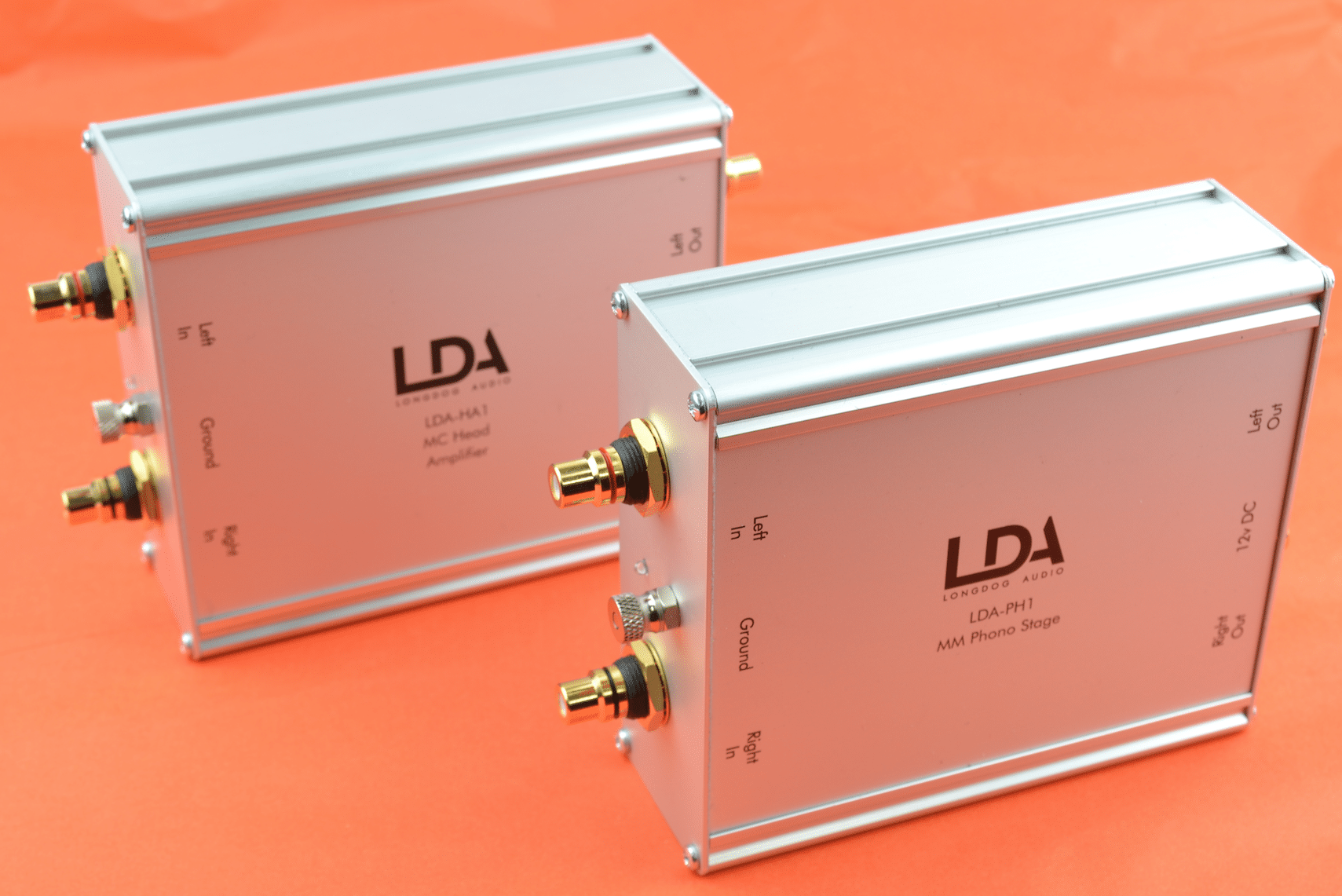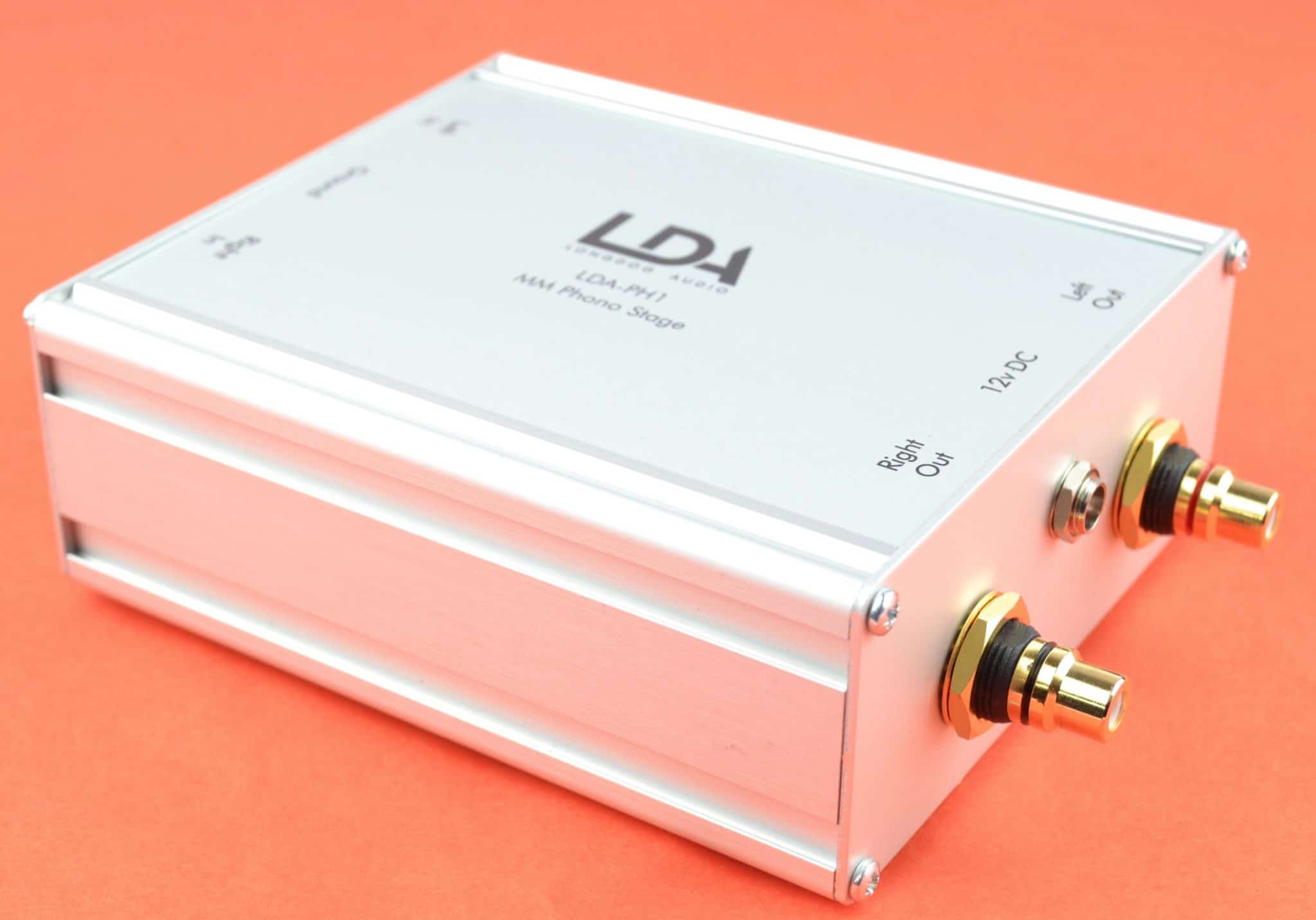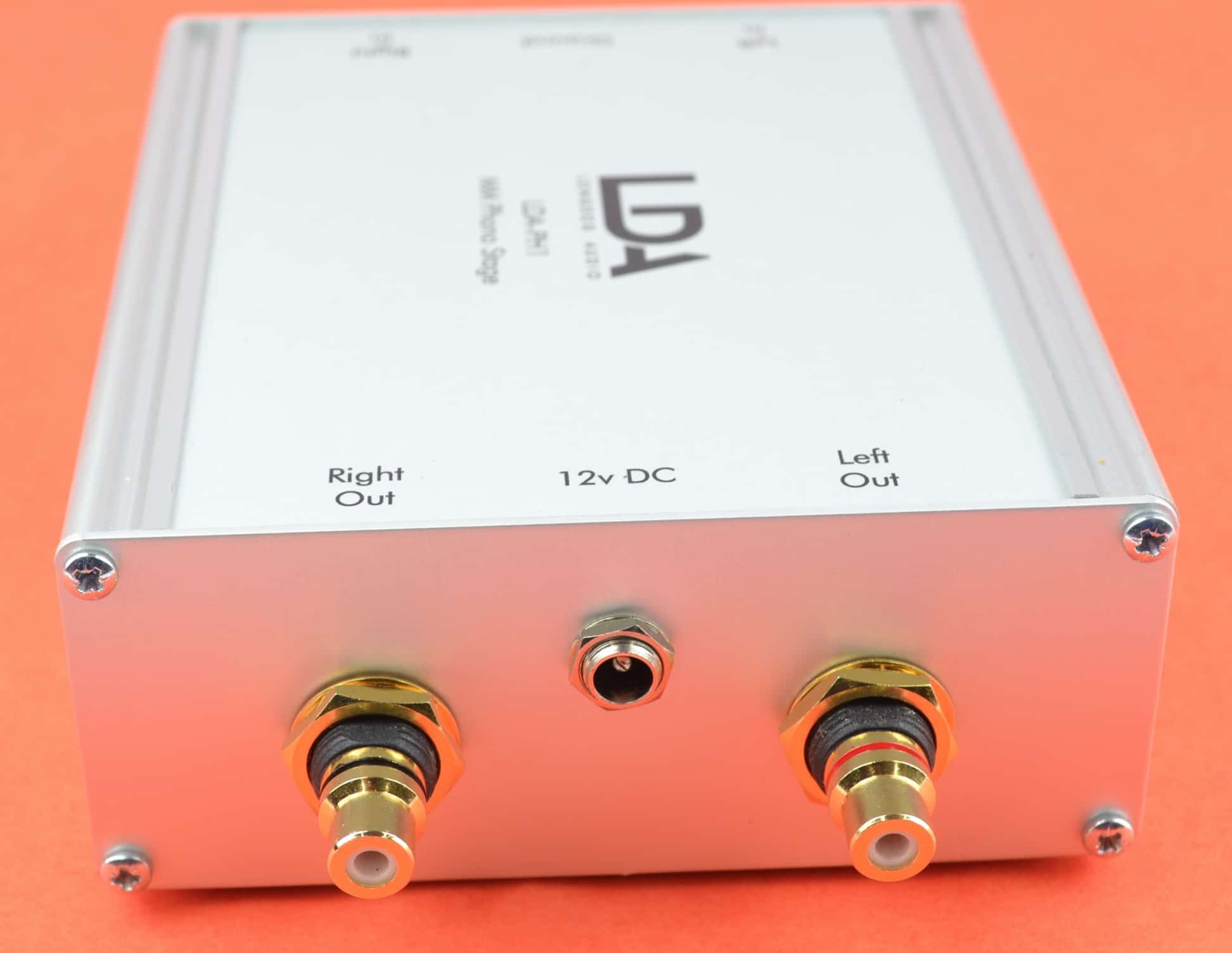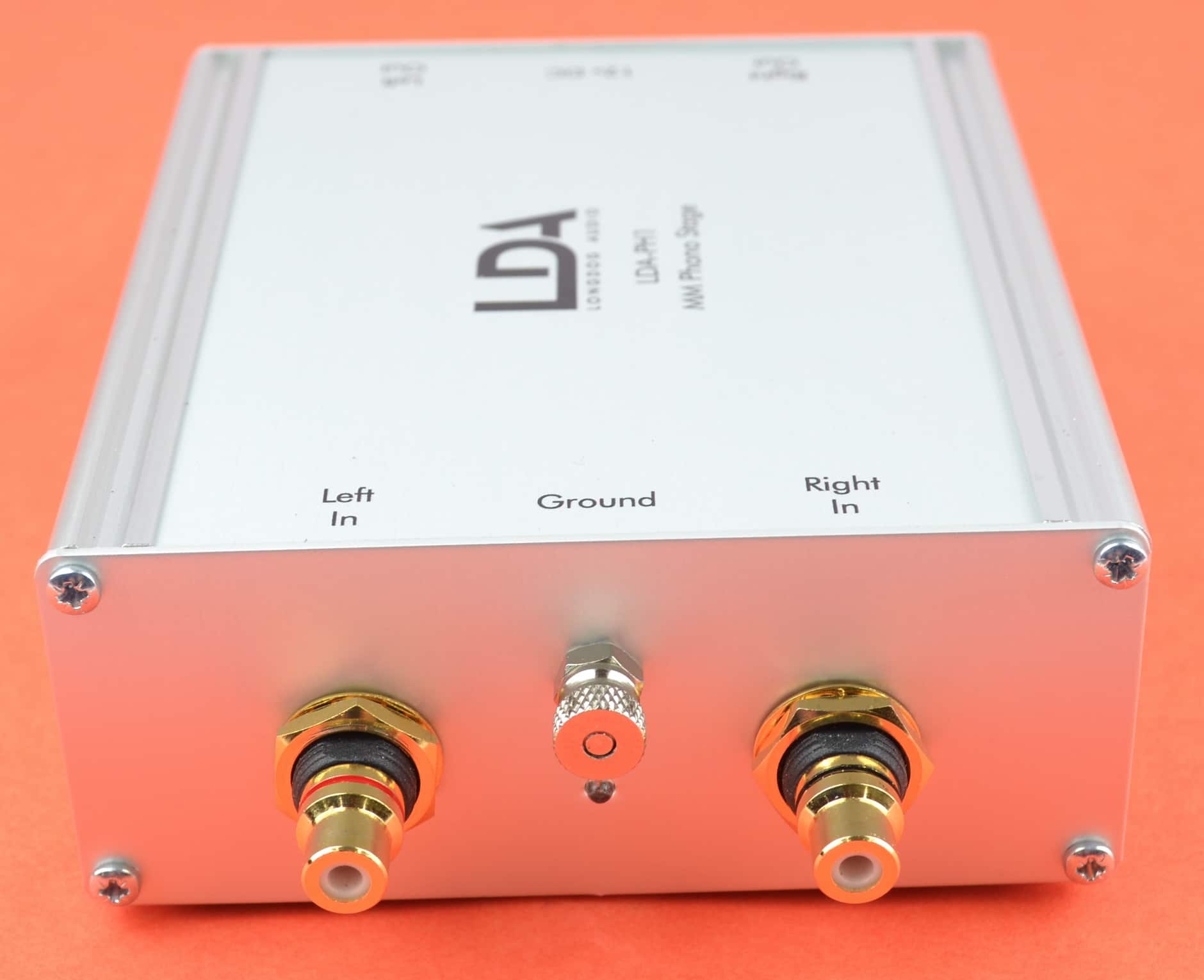The Article
PH-1 & HA-1 Phono Amplifiers From Longdog
11th June 2018

New out and UK-built are the Longdog Audio PH-1 Moving Magnet and HA-1 Moving Coil (Bridge) phono stages, Paul Rigby reviews both
Both occupying a small footprint chassis (108 x 45 x 160mm), both powered by a wall wart 12V power supply and tipping the scales at around 340g or so, the PH-1 is aimed at moving magnet cartridges while the HA-1 is a bridge unit that connects to the PH-1 and allows you to play moving coil cartridges.
The PH-1 makes use of both isolated and regulated power supply technology combined with second stage inductive filtering and third stage active regulation.
“High accuracy RIAA equalisation is achieved by the use of precision components throughout,” said owner and designer, Nick Gorham.
There are no electrolytic capacitors in the unit, all filtering and smoothing is done using film capacitors. The unit is housed in aluminium casework and features gold-plated RCA sockets.
The HA-1 is technically known as a ‘head amp’. This doesn’t mean a headphone amplifier. It’s a bit like a step-up transformer which you attach to a standard moving magnet phono amplifier. When connected, the combo adds 20db of gain and allows you to play moving coil cartridges safely. The reason that a head amp is called a head amp and not a step-up transformer is because the latter is passive and not powered while the former is active so you plug it into the mains.
The build quality of both boxes is excellent. For the price, they feel solid and provide confidence during use. I particularly like the fact that the ground knob is centrally placed, up and away from the RCA sockets. My pet peeve is trying to attach turntable cable ground wires onto a phono amp’s ground connection with no finger room because the design is way too cramped. Longdog has got this – relatively minor but oh so irritating – problem right.
SOUND QUALITY
I began with the MM box first and used the Kansas LP, Leftoverture, a slice of power rock/prog reissued by Speakers Corner.
Before the sound tests began in earnest, I noticed that the gain on this unit was a little high, I had to lower my pre-amp gain by three notches. This is not necessarily a bad thing although I prefer not to have emphasis here. I find it can add unnecessary stridency in terms of the upper mids. Almost like having a smidgeon of compression in and around the highs.
Budget phono amps are tough to build and get right in sonic terms. A good amp will shun any type of midrange brightness or bass blur and will provide a measure of accuracy. They will sound pretty clean and scrubbed and will normally be full of pace and energy. In isolation, they also sound pretty darned good and will entertain you with no issues.
The problem with even pretty good phono amps at this price point is midrange insight and the overall structure of the soundstage. That’s why they’re budget and that’s why they’re affordable.
It’s rare for a phono amp from this budget stream to provide any sense of depth. If you’ve had experience listening to more expensive models, you’ll realise that phono amps in this sector can sound one dimensional. Literally. What I mean is, you feel that you could rise from your chair and approach the soundstage and actually see the edge of it and then nothing behind it at all. A soundstage created like a pane of glass, in effect.
I’ve taken time to explain all of this because I want to illustrate how different the PH-1 is in sonic terms. To begin, there is a host of upper midrange complexity of offer which is a bit of a shock for this price, let me tell you.
If you’ve ever played chess, you’ll know that you initially place particular pieces on certain parts of the board. That’s how the PH-1 presented the music here. The soundstage sounded like every instrument had been placed around the soundstage is a deliberate manner which gave the sound a welcome confidence. Then, when every one of them started belting out music, the entire picture provided that complexity I mentioned.
Even then, with other models, you can often have the sound of a guitar bumping into the drums, causing midrange smearing and a claustrophobic sense to the presentation. Not here, the PH-1 provide enough space and air to give each instrument room to manoeuvre.
Thus, the PH-1 was able to provide a satisfying combination of delicacy and substance, a fragility combined with a strength. Especially when secondary percussion ran hand-in-hand with a bass guitar, for example. And while bass was strong, offering a meaningful impact and the mids were detailed with a treble that was admirably dainty, it was the overall mix that impressed me more and how balanced the overall sound was.
Because of the purity of the build, the simplicity of the design and the direct nature of the construction to get the sound from A to B as fast as possible and without rating over noise creating mechanics, the extra gain I mentioned above wasn’t an issue, so shouldn’t be seen as a problem. Still, I would have loved to have heard that gain reduced, just to see what would have happened.
I then plugged in the HA-1 and PH-1 together as a bridged combination (see the accompanying images to see how this combo works) and switched to moving coil and jazz via Sarah Vaughan and the Mercury original LP, Sassy Swings Again.
At this point, I want to pause and digress slightly and pass on a tip. The Longdog gear is directly involved so I think it’s worthwhile putting this experience ‘on paper’.
I had taken a break after reviewing the PH-1, had a coffee, made notes on my laptop, mooched about and then came back to connect both Longdog units to play a MC cartridge and so connected my reference phono amp first to help in listening comparisons to do just that. Only to be hit by an aggressive hydraulic drill and crackling noise from my speakers. Thinking that there was a possible electrical fault in my reference phono amp, I decided to double check to confirm so connected the new Longdog (now) dual box set-up. The drilling remained. So the fault wasn’t with the phono amps. Also, the noise hadn’t altered in any way. From that point began two to three hours of mind-numbing filtering to exclude the turntable, then the pre-amp, the monoblocks, the speakers and even cabling and power blocks. I swopped in and out around three tons of equipment (well, it seemed – and felt – like it) to find the fault. The drilling sound remained. I sat, stumped. And then something hit me. I walked into the corner of my room and turned off my Wi-Fi Extender. Gone. The noise disappeared. I had forgotten to disconnect if while I was making those notes I mentioned above.
I normally turn this thing off before I do sound tests because Wi-Fi normally produces a low burbling sound through my speakers but also veils the mids during play. Why didn’t I recognise the sound using my lower cost phono amps? I assume that, at this price point, the inherent shielding is either less effective or missing altogether. Hence, with the Extender on, what sounds like a car purring via my expensive Icon Audio two box phono amp sounds here like armageddon with a low cost phono amp in play.
The moral of the story? Check that you switch off all nearby Wi-Fi aerials, phones, laptops and the like before you play your music – especially if you’re using budget kit as I’m testing here. I now know just how susceptible and wide open this sort of kit is to outside influences so think laterally about other types of more insidious and less obvious noise that might cause issues, other electrical equipment that might ‘broadcast’ through the air or leak noise through the mains. If it looks and sounds suspicious, try your best to turn it off before you use your hi-fi. Although be prepared for a fight with the family if you shut down the Router.
Back to the Longdog gear and the PH-1/HA-1 bridged combo.
Maybe it’s because the bridge mode, by default, forces the signal to move through an additional step, that extra piece of hardware – two boxes instead of one plus a new set of cable interconnects, the midrange sounded a little warm and a tad veiled with a little bit less space than I really wanted.
There was still plenty to like here with the bridged Longdog boxes providing a easy going presentation. Detail was available in abundance with effective cymbal taps in evidence and even shy piano sounds targeted by the ear. In additional there was no sign of any frequency nasties here. No bass bloom, midrange brightness or pinched treble. In general terms, the soundstage was well behaved and disciplined. Yes, there was a slight lack of excitement in terms of emotion and passion while dynamic reach was rather stunted because the mids sounded a little rolled off at the top but the warming approach to the bridged mode was also attractive and easy on the ear. Any hi-fi chain with a slightly aggressive edge to it would be effectively calmed by this bridged pairing and can be recommended as a cure for such a set-up.
CONCLUSION
Both the HA-1 and the PH-1 offer superb structural designs and work well during tests.
I need to break down the conclusion into pieces because it’s not a simple bottom line here. In fact, the HA-1 needs two conclusions. In ultimate terms, looking at the music output on its own merits and without taking into consideration any other factors, the reference music is not shown in its very best light through the HA-1. The sonics were solid, detailed, good bass and no horrible frequency noises but the upper mids were rolled off a little bit. But I’ll add this, the HA-1 will be a complete life saver for those on a budget who want to get in on the Moving Coil act. If you can’t afford £1,000 on a damn good MC phono amp, you already have a MM phono amp and you want to upgrade but only have £200 in the kitty then, on that score, £200 to be able to successfully run a MC cartridge is silly money. It’s chicken feed considering – in these specific and relative terms – how good the sound quality of the HA-1 is.
Put another way? In black and white sonic terms, its not perfect but as a cheap moving coil phono amplifier upgrade? It’s a bargain.
The star performer of this entire review, though – partly because of the purity of its position in the hi-fi chain as well as its inherent design – was the PH-1. This MM phono amp is an absolute corker and is highly recommended for any and all budget vinyl-based hi-fi systems. It provides both maturity and richness, in sonic terms and punches way above its weight. Buy it and be happy.
LONGDOG AUDIO PH1 MOVING MAGNET AND HA-1 MOVING COIL PHONO STAGE
Longdog PH-1
Price: £199.95
Tel: 07812 249747
Website: www.longdogaudio.com
GOOD: sparkling mids, airy soundstage, firm bass, balanced performance, build
BAD: nothing
RATING: 9
Longdog PH-1/HA-1 Bridge Mode
Price: £199.95
Tel: 07812 249747
Website: www.longdogaudio.com
GOOD: warm sound output, detail, bass response, build quality, upgrade role
BAD: veiled mids
RATING: 7
Don’t forget to check out my Facebook Group, The Audiophile Man: Hi-Fi & Music here: www.facebook.com/groups/theaudiophileman for exclusive postings, exclusive editorial and more!]
REFERENCE
Rega Planar 3 turntable
Cambridge Azur 551P phono amplifier
Rega Brio-R amplifier
Spendor A1 speakers
Black Rhodium cables
Blue Horizon Professional Rack System
Harmonic Resolution Systems Noise Reduction Components
All vinyl was cleaned using an Audio Desk’s Ultrasonic Pro Vinyl Cleaner













Hi Paul, great review. I love seeing reviews of small, new home grown brands that seem to be getting things right from the start. I’ve been reading reviews for months trying to choose a new phono amp (I’m using the built in one in my elex-r at the minute). ¬£200-¬£300 is my max. Do you think this will be a step up from the built in phono amp (it’s the only built in amp I’ve been impressed by)?
Hi Patrick – thanks for your question. Yes, absolutely. External phono amps are superior because they are not infected by electronic noise, which masks fine sonic detail, being away from the amp’s chassis and the electronics within it. Grab the Longdog, by all means. When in use, please keep it away from the main amp.
Thanks Paul. I’ll give it a shot. I’m using an ortofon 2m red on my project debut 3 which sounds great but I’m always looking for upgrades.
Hi Paul, I recently got an Audiolab 6000a amp, which sounds great (thanks a lot for your quality review), and thinking of adding a separate phono stage to it. I am debating between LDA PH1 and Schiit Mani. At the place where I am living, both would be shipping internationally, and at the end PH1 would cost about $150 USD more. While my budget is allowed, I was wondering if the difference in sound quality is worth the price gap. Thank you.
If cash is tight and you’re thinking twice about the extra $150 then stick with the Mani, you won’t be disappointed. The Longdog is an excellent phono amp though and highly recommended if you can stretch to its price point.
Hi Paul,
I just noticed this review from last year. As you may remember from previous discussions, I have a custom-made VDH MM P-mount cartridge on a Technics linear tracking SL-DL1 turntable, hence why I’m not really looking to move to MC. I currently use the inbuilt MM phono amp in my Denon AVR 3803, and the sound really is great (through my Tannoy A145s), so will I notice a marked difference if I get a PH1?
I ask this because I already had a vast improvement in 3D staging when I got the VDH cartridge, not to mention a large general improvement in all sound, when I upgraded from a Yamaha amp to the Denon, which is a very clever design, including a “pure direct” option. I suppose I’m wondering if there’s much more I can improve without a major change – especially given all the linear crystal cabling I use.
I was intrigued to read your comments on wi-fi, and also on phono amp placement. I’ve certainly never noticed any wi-fi interference on my system, so that worries me in regard of the PH1, as my router is in the same room as the hi-fi. I definitely don’t want to be having to knock the router off every time I want to put a record on.
I’m also wondering where I can place the phono amp in relation to the Denon? I noticed you told Patrick to keep it away from the main amplifier. The turntable is on the shelf above the Denon, so it could go next to the turntable perhaps (the shelf is wide enough), but it would only have a 6″ vertical clearance from the Denon. Would that be sufficient?
The last question that came into my mind was, if your amp already has a grounding screw, are you better relocating the turntable ground to the phono amp, or should you leave it in the main amp?
Sorry I’m asking so many questions, but I’ve never used a separate phono amp before, and I like your description of the design & performance, so I’m seriously considering the PH1, if you think it will make a good improvement for me.
Cheers.
Marcus.
Hi Marcus – in 99% of all cases, a separate phono amp will reap sonic rewards when compared to an internal model. Everything makes a difference, improving your cart – yes – but that’s one of hundreds of improvements you can make to your system and, for each of those, you’ll hear improvements (cash not withstanding, of course 🙂 )
As for your router? It’s an option, not everyone will want to do this. Might be worth trying, though. A suggestion? Listen to one of your fave records for an hour, the same track if possible. Over and over. Seek out each and every instrument in the mix, get to know each one (pick an instrument for one run through and then another instrument for a second run though, etc) and what it’s trying to do. Especially those instruments lying behind the headline elements in one track (e.g. a delicate cymbal tapping behind a big lead guitar solo). Then, when you’re thoroughly fed up with that track, turn the router off play the track again and see if there’s more air and space available, possibly more focus around the bass, whatever it might be.
Isolate the phono amp as best you can. Again, everyone has different circumstances so I realise there may be space issues. If there’s a shelf in the way of your phono amp and Denon then that’s a good start.
And the phono amp ground is best for turntable ground. The amp ground is ideal for general grounding kit like the Russ Andrews I reviewed a while back. That’s what that’s really for: https://theaudiophileman.com/rf-router-mkii-review-russ-andrews/
Couldn’t find anything about the HA-1 on Longdog’s site, even after searching on it. Is it discontinued
Well that’s a shame if that’s correct, it was a good little phono amp.
Yeah. I’ve moved on to pastures new. See my other question in the phono amp buyers guide.